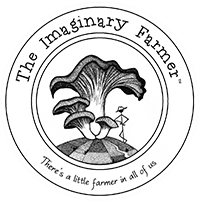The Zero-waste mushroom pot project has several overlapping goals that I thought I should list out before going into more detail on what I have tried and what I am asking people to work on with me. You could come up with different designs that would work equally well for certain purposes, as people have done many times successfully, so what do we want to accomplish with this project, and how does it differ from what lots of people have already done?
The mushroom pot should serve as a detailed, easily-understood case study of how to produce mushrooms in an effective, environmentally-sound way by using simple, if slightly unconventional, methods. It should provide an example that anyone can easily adapt for different purposes. I use the word Mushroom Pot to put the focus on the container, because the materials used in a lot of mushroom production – primarily polypropylene bags – result in so much solid waste that, in the best of circumstances, ends up in landfills, but if not disposed of properly tend to break into tiny, long-lasting shreds that spread through the environment all too easily.
If someone invents a fully bio-degradable plastic film that can withstand pressure sterilization, of course, everyone one can switch to using that without having to change anything else about their production methods. That may not happen, though, so in addition to hoping the problem gets solved with a new miracle material, we might as well try methods that work with existing, safer materials so we don’t need the problem materials in the first place.
To make a credible alternative system the mushroom pot should have the potential to serve a wide range of potential users, ranging from hobbyists to
commercial growers over a wide range of mushroom species (not just oysters) and supporting various substrates, for spawn and bulk (fruiting) units.
First, as the first general rule for the project, every component of the mushroom pot concept should lend itself to practical – not just theoretical – reuse, and/or recycling, and/or composting.
As a second general rule, anyone should be able to acquire the materials and use the methods developed here with minimal expense to produce viable mushroom pots from scratch, and with only the technology available in a typical residential kitchen.
These are the applications I would like the mushroom pot to work for:
For educational use, the container should be available in a clear material to show mycelium colonizing the substrate. It should also be small enough, and inexpensive enough, that a class can use several in a limited space, to allow for testing a number of different experimental variables at once. I would like to use it in a replacement for our now-discontinued Grow-it-Yourself oyster mushroom kit.
The container should work for a variety of species, though initially it has to work for the very forgiving oyster mushrooms of the genus Pleurotus. Different species may require somewhat different materials and techniques but the same basic process should work for all.
For indoor gardeners it should likewise be small and inexpensive enough to allow for meaningful personal food production in limited spaces, for instance, in spaces between plants under lights in an apartment, or on a kitchen counter.
For outdoor gardeners it should allow for producing large enough units for outdoor plantings, for log inoculation, and the like.
For scalability the container and the methods for using it should easily apply to larger containers and to producing commercial- or farm-scale numbers of units. In other words, it should provide an example that others can learn from to produce food not just for themselves but for sharing with friends and neighbors, or for sale.
It should also serve as the basis of a mushroom ‘kit’ that could be sold online or distributed through retail outlets, as fully colonized substrate ready to start forming fruiting bodies at a convenient price and size that a consumer could easily pick up at a grocery store or garden center and grow out at home.
I assume the method we will use at the start will be Rush Wayne’s peroxide method of non-sterile cultivation. His methods have helped people all over the world start cultivating mushrooms with minimal facilities. I have used variants of Wayne’s method for years, and our Grow-it-Yourself mushroom kits used it successfully to make it easy for people with no mushroom growing experience to inoculate a substrate and grow it to fruition – and to see the whole process. Other methods that also do not require pressure sterilization of the container could certainly work, and I’d like to experiment with them, all in good time.
I have been using the peroxide method with deli cup-type containers with good results. I have grown oysters (Pleurotus pulmonarius) and Hen-of-the-Woods (Grifola frondosa) and a smattering of others in them, and I don’t think it will prove difficult to find ways to make it work well for quite a few species. Each one does have its particular needs and habits, though, which call for particular refinements. I will go into what I have learned so far and what we still need to know in the next post.
